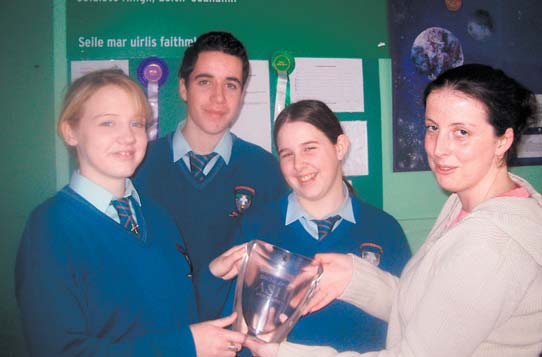| 2005 |

|
YEAR BOOK |
Col�iste Ailigh, Letterkenny, Co. Donegal
|
Saliva as a diagnostic tool
|
Smoking is very harmful and it can create high levels of cyanide in the body. We set out to investigate the levels of cyanide in smokers and non-smokers. From this we could also find out how harmful passive smoking is.
Sampling of blood for biochemical analysis is one of a number of essential tools in diagnosis of disease and evaluating health status of patients. We were concerned with the invasive nature of such tests and wanted to investigate the feasibility of using saliva as a diagnostic tool. Our local hospital biochemistry department agreed to assess the saliva samples.
We were looking for a test that was reasonably low cost, reliable and simple to perform. From an article describing a test on urine to determine the cyanide content of foodstuffs by analysis of thiocyanate, we developed a method of analysing thiocyanate in saliva that obeys our criteria.
Saliva was chosen as the best medium because of its reported high content of thiocyanate, the stability of thiocyanate in saliva (half life 10 days) and the fact that testing would be non-invasive. Both blood and urine had been reported as being subject to interference from thiocyanate in the diet, whilst saliva was reported as being unaffected.
We have developed a cheap, portable and easy to use method for measuring thiocyanate in saliva. We have confirmed its accuracy by comparing it with a more standard laboratory method (elution and colour-meter reading).
It is interesting that our tests show that the mean level of thiocyanate found for non-smokers is 3-4 times lower than that for students who stated that they do smoke. The large number of low values is encouraging, as it would confirm the belief that dietary sources do not interfere with this testing method. However, our results show that whilst a small number of our sample students smoked, an equal number demonstrate high levels of thiocyanate from passive smoking.

| This article was sponsored by ASH Ireland |
|---|